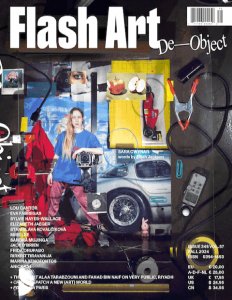
Covers: Mire Lee photographed by Hyesoo Chung / Sara Cwynar , self-portrait /
Sandra Mujinga photographed by Elliot Jerome Brown Jr.; features: Letter from the Editor;
Cover Story Mortal Machines Mire Lee by Louisa Elderton;
Cover Story Fantasies of Value Sara Cwynar by Elijah Jackson;
Cover Story Of Shadows
Sandra Mujinga by Bernardo José De Souza; Submit To The Black Compost.
Rirkrit Tiravanija in Conversation with
Hans Ulrich Obrist; Live Forever.
Anicka Yi by Dean Kissick;
Focus On Paris Same is More: Parisian Architecture
à l'identique by Octave Perrault; In the Cut.
Frida Orupabo by Natasha Hoare;
Critic Dispatch A New (Art) World by Collecteurs;
The Curist Very Public, Riyadh Alaa Tarabzouni and Fahad Bin Naif in Conversation with Oliver Farrell; Glory Whole. Jack O'Brien by Caroline Elbaor; Storm Girl. Elizabeth Jaeger in Conversation with
Estelle Hoy; How You're Supposed To Be. Sylvie Hayes-Wallace in Conversation with Margaret Kross;
Unpack / Reveal / Unleash Edgeplays. Stanislava Kovalčíkova by Alex Bennett;
Letter from the City ICU* sometimes by Lou Cantor; reviews: Steve McQueen "Bass" Dia:Beacon, New York by Valerie Werder; Donald Rodney "Visceral Canker" Spike Island, Bristol by Frank Wasser; Marianna Simnett "WINNER" Hamburger Bahnhof, Berlin by Philipp Hindahl; Katharina Grosse "Shifting the Stars" Centre Pompidou-Metz by Margot Nguyen; Jana Euler "Oilopa" WIELS, Brussels by Pierre-Yves Desaive; "Arcadia" Bally Foundation, Lugano by Michela Ceruti; Dana Schutz "The Island" The George Economou Collection, Athens by Nicolas Vamvouklis.
"DE-OBJECT," Flash Art's fall issue, focuses on artists who explore acts of recomposition and decomposition, the undoing of objects and their constituent parts, whether organic, kinetic, ephemeral, gustatory, olfactory, or simply in a state of flux that lends itself to a thematic designation.
In this issue Louisa Elderton writes about Mire Lee's work: "Her abstract installations often evoke the body in its amalgam of form and material: corporeal masses gaping or pierced, leaking or writhing, barely holding themselves together." On the occasion of her Hyundai Commission at Tate Modern's Turbine Hall, from October 8, 2024, to March 3, 2025, Lee is the subject of the first cover story of this issue. She was photographed in her Berlin home by Hyesoo Chung, wearing outfits by Hyein Seo.
A number of artists seem to be grappling with similar approaches to physically mutable yet ultimetly eternal forms. Anicka Yi's desire to continue making art from beyond the grave is investigated by Dean Kissick in this issue, while Rirkrit Tiravanija discusses with Hans Ulrich Obrist the idea of activating art collectively. The two long-time friends discuss a redistribution of value, particularly in reference to Tiravanija's retrospective "A LOT OF PEOPLE" at LUMA Arles, organized in collaboration with New York's MoMA PS1.
Sara Cwynar was invited to create a special self-portrait for the second cover story of the issue, which also includes a collage of stills from her new video work Baby Blue Benzo (2024), set to be showcased in her solo exhibition of the same name at 52 Walker, New York, from October 4 to December 21, 2024. Author Elijah Jackson posits how Cwynar's "preoccupations and vocabulary of the image maneuver between discipline, place, and degree of physicality, unsettling any concept of the real."
The third cover story is dedicated to Sandra Mujinga, whose solo exhibition "Time as a Shield" will be on view at Kunsthalle Basel until November 10, 2024. Mujinga, wearing Kuboraum & Innerraum glasses, was photographed by Elliott Jerome Brown Jr. in her studio at ISCP, New York. Bernardo José de Souza beautifully describes her chimeric, ghostly, elongated otherworldly beings, pondering whether they are "warriors, robots of sorts, rebels, or mercenaries. Are they humans in disguise, or is disguise a humanoid feature? Are they there to look after us humans, or, conversely, to defeat humankind?"
This issue comes with three different covers, randomly distributed.
Flash Art is a contemporary art and culture magazine founded in 1967. Within a decade, it became an indispensable point of reference for artists, critics, collectors, galleries, and institutions. In 2020, Flash Art became a quarterly publication, at the same time increasing its trim size and updating its graphic identity. The magazine offers a fresh perspective on the visual arts, covering a range of transdisciplinary approaches and fostering in-depth analyses of artist practices and new cultural directions. Today, Flash Art remains required reading for all who navigate the international art scene.
Flash Art is known for it covers featuring artists who subsequently become leading figures in the art world. The magazine includes photoshoots, productions, critical essays, monographic profiles, conversations with emerging and established artists, and a range of ongoing and thematic columns that change every few years. The long history of the magazine is also highlighted by pivotal texts from the archive that are included in the publication time to time. Finally, every issue offers a highly curated selection of the best institutional exhibitions on the global scene.
